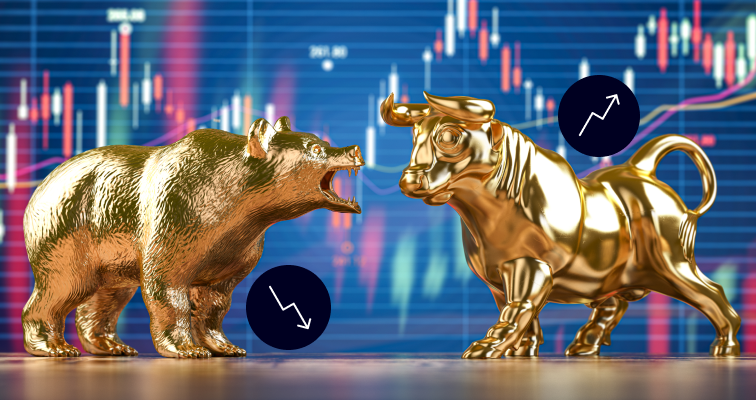It’s easy for beginner investors to feel overwhelmed by the complex nature of the financial markets, especially because there are hundreds of terms and buzzwords to learn and understand. Our experts have broken down the most important pieces of jargon, to help make the process of investing less confusing.
Establishing a better understanding of the industry-specific terms used by investors is a crucial part of developing an effective investment strategy. Having a clear understanding of what you trade, and how you trade it, can better help you understand why you might want to trade it.
Essential Investing Terms: A Comprehensive Guide for Beginners
Risk comes from not knowing what you’re doing.
Warren Buffett
What are capital markets?
Capital markets are where buyers and sellers exchange cash — or capital — in return for ownership rights of an asset. They can trade or invest in financial instruments ranging from stocks to cryptoassets, in the hope of generating a return.
Tip: Capital markets include institutions, such as stock exchanges, that support ongoing trading and allow assets to be bought and sold repeatedly.

What is volatility?
Volatility is a measure of an asset’s price changes within a given time. Volatility gives an indication of the levels of risk associated with investing in a particular market. The risk tolerance of individual investors will determine whether they are better suited to trade in low, medium or high volatility markets. Volatility is calculated using historical data and influencing factors can change the rate of volatility over time. These factors can be asset-specific or events that impact the wider market.
What is an investment portfolio?
A portfolio is a group of assets acquired by an investor. It can include stocks, bonds, commodities, currencies, funds, property and cryptoassets. Investors can track the price movements of their assets through their portfolio.
What is a dividend?
Dividends are payments issued to shareholders as a reward for their investment. Dividend payments are made on a pro rata basis; the more shares you own, the greater the total dividend received.
Tip: When cash dividends are reinvested and used to buy more stock, the compounding effect takes place, allowing your stock position to grow over time.
What is an IPO?
An initial public offering (IPO) occurs when a privately owned company makes some or all of its shares available to the public, through a stock exchange. The founders of the firm receive cash for the stock they sell, and investors can buy into the future prospects of the company.
Long vs short
Going “long”, or taking a long position, is used to describe the act of buying an asset, such as a stock or bond. This is done when an investor believes the price of the asset will increase in the future.
Short selling, or “shorting”, involves selling an asset you don’t already own. Investors effectively borrow an asset and then sell it, in the hope that the price of the asset will fall after it is sold. This would allow them to purchase it back for a lower price than they sold it for originally, thus, profiting from the price difference.
Tip: Investors can use CFDs to sell short, in the belief that they will be able to buy it back in the future at a lower price.

Bear vs bull markets
Traders use the terms “bear market” and “bull market” to describe price movements and market conditions. A bear market is one where the underlying price move is downwards. On the other hand, bull markets are those where the price is heading upwards.
The terms are used quite loosely to help explain general feelings within a market, but the widely accepted definition requires the price to have moved by more than 20% from a previous peak or trough.
What is an index?
An index is a measure of the value of a group of assets. The grouping can be determined by factors such as asset class, geographical region, industry or sector. For example, the FTSE 100 stock index measures the value of the 100 largest firms listed on the London Stock Exchange, and the S&P 500 Index tracks the performance of the stocks of the 500 largest companies listed in the United States.
Having a clear understanding of what you trade, and how you trade it, can better help you understand why you might want to trade it.
What is a Stop-Loss?
A Stop-Loss is an order you place with your broker to buy or sell an asset you are holding when its price reaches a certain level. Stop Losses are used to limit losses and manage risk, even if you are not actively monitoring your account.

What is the stock market?
Stock markets are exchanges that support the buying and selling of equities. They are licensed and monitored by financial regulators and have rules and regulations regarding which companies are eligible to be listed on them.
What is interest?
Interest is the price you pay to borrow money, or the cost you charge to lend money. The amount of interest is usually expressed as a percentage, referred to as the “interest rate”, and depends on a range of factors, including the creditworthiness of those involved.
What is asset allocation?
Asset allocation is the process of deciding how much capital is to be invested in different financial instruments. Portfolio rebalancing occurs when investors adjust their asset allocation in response to changes in market conditions or if they decide to pursue a different strategy.
Final thoughts
Gaining a better understanding of the terms used in the financial markets can help you to become a better investor, with additional knowledge potentially leading to better financial decisions. It should be approached as an ongoing process, but the above terms are a great starting point, and will serve as the foundation for a solid understanding of investing.
Visit the eToro Glossary to learn about more investing terms.
Quiz
This information is for educational purposes only and should not be taken as investment advice, personal recommendation, or an offer of, or solicitation to, buy or sell any financial instruments.
This material has been prepared without regard to any particular investment objectives or financial situation and has not been prepared in accordance with the legal and regulatory requirements to promote independent research. Not all of the financial instruments and services referred to are offered by eToro and any references to past performance of a financial instrument, index, or a packaged investment product are not, and should not be taken as, a reliable indicator of future results.
eToro makes no representation and assumes no liability as to the accuracy or completeness of the content of this guide. Make sure you understand the risks involved in trading before committing any capital. Never risk more than you are prepared to lose.


